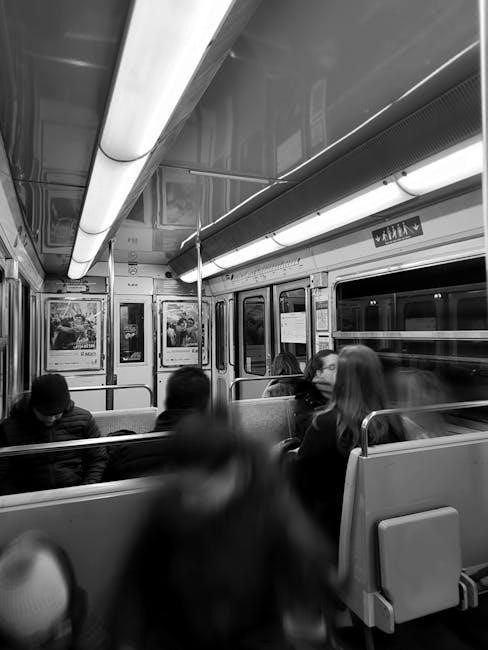The Underground Railroad was a secret network helping enslaved African Americans escape to freedom in the 19th century. It involved hidden routes‚ safe houses‚ and courageous individuals like Harriet Tubman and Frederick Douglass‚ who risked everything to fight slavery and oppression. This system‚ not an actual railroad‚ symbolized the fight for freedom and equality‚ becoming a powerful symbol of resistance and resilience in American history.
By understanding its history‚ routes‚ and key figures‚ we honor the bravery of those who sought freedom and challenged the injustices of slavery. The Underground Railroad remains a testament to the human spirit’s pursuit of liberty and justice.

Historical Background of the Underground Railroad
The Underground Railroad emerged in the late 18th century‚ becoming a vital network for enslaved African Americans seeking freedom. It was shaped by the harsh realities of slavery‚ the Fugitive Slave Laws‚ and the growing abolitionist movement in the North. This secretive system symbolized resistance against oppression and played a pivotal role in the fight for freedom and equality in pre-Civil War America.
Origins and Purpose of the Underground Railroad
The Underground Railroad originated in the early 19th century as a clandestine network to assist enslaved African Americans in escaping to freedom. Its roots trace back to the growing tensions over slavery and the Fugitive Slave Act of 1793‚ which intensified the need for a secret system. The network was not a physical railroad but a series of hidden routes‚ safe houses‚ and coded communication used by freedom seekers and abolitionists. Its primary purpose was to provide a pathway for enslaved individuals to escape the oppressive conditions of slavery in the South and reach free states in the North and Canada.
The system relied on the bravery of conductors like Harriet Tubman and the support of abolitionists who risked their lives to fight for freedom and equality. It became a powerful symbol of resistance and hope for those seeking liberation.

Important Figures in the Underground Railroad
Key figures included Harriet Tubman‚ Frederick Douglass‚ and abolitionists who risked their lives to help enslaved individuals escape. Their bravery and leadership were instrumental in the fight against slavery.
Harriet Tubman: The “Moses of Her People”
Harriet Tubman‚ known as the “Moses of Her People‚” was a fearless conductor of the Underground Railroad. Born into slavery‚ she escaped to freedom in 1849 and returned multiple times to guide approximately 70-80 enslaved individuals to freedom. Her unwavering courage and knowledge of secret routes earned her legendary status. Tubman used coded songs‚ disguises‚ and nighttime travel to evade capture‚ never losing a passenger. Her work as a spy and nurse for the Union Army during the Civil War further solidified her legacy. Tubman’s resilience and determination made her a symbol of freedom and resistance‚ inspiring generations to fight against oppression. Her contributions remain a cornerstone of the Underground Railroad’s history‚ highlighting the power of individual activism in the pursuit of justice and equality.
Frederick Douglass: His Role and Perspectives
Frederick Douglass‚ a former slave turned prominent abolitionist‚ played a pivotal role in the Underground Railroad. While he personally escaped to freedom in 1838‚ Douglass became a vocal advocate‚ using his powerful oratory and writing skills to expose the horrors of slavery and support the network. He published detailed accounts of his experiences‚ which helped raise awareness and garner support for the abolitionist cause. Douglass’ perspective on the Underground Railroad was critical; he believed it was a vital tool for freedom but expressed concerns about its lack of secrecy‚ fearing increased risks for those involved. His work as a publisher and speaker made him a key figure in the movement‚ though he sometimes disagreed with its methods. Douglass’ contributions remain essential to understanding the broader struggle for freedom and equality in 19th-century America.
The Role of Abolitionists and Conductors

Abolitionists and conductors played a crucial role in the Underground Railroad‚ forming the backbone of the network. These individuals‚ both African American and white‚ risked their lives to help enslaved people escape to freedom. Conductors like Harriet Tubman and William Still guided escapees through dangerous routes‚ often under the cover of night‚ while abolitionists provided safe houses‚ food‚ and resources. Many were deeply committed to the cause‚ driven by moral and ethical opposition to slavery. The network relied heavily on their bravery‚ resourcefulness‚ and willingness to defy the law. Despite the constant threat of capture‚ imprisonment‚ or even death‚ these individuals remained steadfast in their mission to liberate others. Their efforts not only saved countless lives but also symbolized the power of collective resistance against oppression. The contributions of abolitionists and conductors remain a testament to the strength of the human spirit in the fight for freedom.

The Underground Railroad in Operation
The Underground Railroad operated as a covert network of secret routes and safe houses‚ enabling enslaved individuals to escape to freedom. Travelers often moved at night‚ guided by abolitionists and conductors who provided food‚ shelter‚ and coded messages to avoid detection. The network relied on the bravery of both escapees and helpers‚ who risked severe punishment to challenge the system of slavery.

How the Underground Railroad Functioned
The Underground Railroad was a clandestine network of routes and safe houses that enabled enslaved individuals to escape slavery in the South. It was not a physical railroad but a system of secret paths and hidden locations. Escaping slaves‚ often guided by abolitionists and conductors‚ traveled primarily at night‚ using coded messages‚ songs‚ and constellations like the North Star to navigate. Safe houses‚ known as “stations‚” provided temporary refuge‚ while “conductors” like Harriet Tubman and Frederick Douglass risked their lives to assist escapees. The network relied on secrecy and trust‚ as betrayal could lead to capture and severe punishment. Despite the dangers‚ thousands of enslaved individuals used this system to reach freedom in Northern states and Canada. The operation was informal‚ with no centralized leadership‚ but it played a crucial role in challenging the institution of slavery and inspiring abolitionist movements.
Routes and Maps of the Underground Railroad
The Underground Railroad consisted of a network of secret routes and pathways used by enslaved individuals to escape to freedom in the Northern states and Canada. These routes were not physically mapped but were passed down through coded messages‚ songs‚ and oral traditions. Many escapees used natural landmarks‚ such as the North Star‚ rivers‚ and mountains‚ to navigate their way. The routes varied‚ with some following the Ohio River or the Great Lakes‚ while others led through abolitionist-friendly communities. Coded messages in songs and quilts often provided instructions for travelers. The lack of formal maps ensured secrecy‚ protecting both the escapees and the helpers involved. Despite the risks‚ thousands successfully used these routes to achieve freedom‚ making the Underground Railroad a testament to resilience and determination.
Safe Houses and “Stations” Along the Way
Safe houses‚ often referred to as “stations‚” were crucial in the operation of the Underground Railroad. These secret locations provided refuge for escaping slaves‚ offering them food‚ shelter‚ and temporary safety. Many of these stations were the homes of abolitionists‚ both White and African American‚ who risked their lives to assist fugitives. The homes were equipped with hidden rooms‚ secret passages‚ or underground areas to conceal escapees from slave catchers. Conductors‚ or the individuals guiding the slaves‚ would often move them from one station to another under the cover of night. The secrecy surrounding these locations was vital to their success‚ as discovery could lead to severe consequences for both the helpers and the escapees. These safe houses symbolized hope and resilience‚ serving as vital stepping stones on the journey to freedom.

Risks and Challenges Faced by Escaping Slaves
Escaping slaves faced immense risks and challenges while traveling the Underground Railroad. The journey was perilous‚ with constant threats from slave catchers and bounty hunters who sought to capture and return them to their enslavers. If caught‚ escapees often endured brutal punishment or even death. Traveling primarily at night‚ they had to navigate unfamiliar terrain‚ avoiding detection by patrols and informants. Harsh weather conditions‚ lack of food‚ and limited resources added to their struggle. Additionally‚ the Fugitive Slave Act of 1850 intensified the danger‚ as it allowed slave catchers to operate in free states. Trusting strangers was risky‚ as some posed as allies but betrayed escapees for rewards. Despite these obstacles‚ many persisted‚ driven by the hope of freedom. Their courage and resilience remain a testament to the human spirit’s determination to overcome oppression and seek a better life.

The Underground Railroad in Popular Culture
The Underground Railroad gained prominence in popular culture through works like Colson Whitehead’s Pulitzer Prize-winning novel‚ which reimagines the network as a literal railroad. This narrative has sparked widespread discussion and reflection on the legacy of slavery and freedom in America.
The Book “The Underground Railroad” by Colson Whitehead
Colson Whitehead’s Pulitzer Prize-winning novel‚ The Underground Railroad‚ reimagines the historic network as a literal railroad‚ blending historical fiction with speculative elements. The story follows Cora‚ a young enslaved woman‚ as she escapes a Georgia plantation and navigates the treacherous journey to freedom. Whitehead’s vivid portrayal explores themes of identity‚ survival‚ and the enduring legacy of slavery in America. The novel has been widely acclaimed for its innovative storytelling and unflinching examination of racial injustice. By transforming the Underground Railroad into a physical entity‚ Whitehead creates a powerful metaphor for the hidden pathways and resilience of those seeking liberation. The book has sparked significant cultural dialogue and remains a critical work in contemporary literature‚ offering a fresh perspective on one of America’s most painful histories.
Overview of the Novel and Its Themes
The Underground Railroad by Colson Whitehead is a gripping narrative that reimagines the historical network as a literal railroad‚ offering a powerful exploration of slavery‚ freedom‚ and identity. The story follows Cora‚ a young enslaved woman‚ as she flees a Georgia plantation and embarks on a perilous journey through a fantastical railroad system. Each stop represents a different state and a unique manifestation of racism and oppression. Through Cora’s experiences‚ Whitehead examines themes of resilience‚ survival‚ and the enduring impact of slavery on individuals and society. The novel intertwines historical facts with inventive storytelling‚ creating a haunting yet hopeful portrayal of the quest for liberation. By blending speculative fiction with historical truths‚ Whitehead sheds light on the brutal realities of slavery and the strength of those who sought freedom‚ making the novel a poignant reflection on America’s past and its ongoing legacy.
Historical Accuracy and Creative Liberties in the Book
Colson Whitehead’s The Underground Railroad masterfully blends historical accuracy with creative liberties‚ offering a unique perspective on the brutal realities of slavery. While the novel fictionalizes the Underground Railroad as a literal network of trains and tracks‚ it remains deeply rooted in the historical context of slavery and escape. Whitehead draws inspiration from real-life accounts of enslaved individuals‚ such as Harriet Tubman and Frederick Douglass‚ to craft a narrative that feels both authentic and imaginative. The book accurately portrays the horrors of slavery‚ the dangers faced by fugitives‚ and the resilience of those seeking freedom. However‚ the literal railroad is a creative invention‚ allowing Whitehead to explore themes of movement‚ progress‚ and the fragmented nature of freedom. This blend of history and fiction creates a powerful narrative that honors the past while offering a fresh lens through which to view America’s complex legacy of slavery and racism;
Impact and Reception of the Novel
Colson Whitehead’s The Underground Railroad has had a profound impact on contemporary literature and societal discourse. Upon its release in 2016‚ the novel received widespread critical acclaim‚ earning the Pulitzer Prize for Fiction in 2017. It was also selected for Oprah’s Book Club‚ further amplifying its reach and influence. The book’s unflinching portrayal of slavery and its inventive reimagining of the Underground Railroad sparked necessary conversations about race‚ history‚ and freedom. Readers and scholars praised its lyrical prose‚ emotional depth‚ and historical resonance. The novel’s success also led to a surge in interest in the real Underground Railroad‚ encouraging readers to explore its history. However‚ some critics noted the novel’s graphic content and emotional weight‚ highlighting the challenging nature of its subject matter. Overall‚ The Underground Railroad has become a landmark work in American literature‚ leaving a lasting impression on its audience and inspiring further exploration of the nation’s complex past.

Legacy and Cultural Impact
The Underground Railroad’s legacy endures as a powerful symbol of resistance and freedom. It inspired abolitionist movements and remains a cultural touchstone‚ honoring the resilience of enslaved individuals seeking liberation.
Historical Significance of the Underground Railroad
The Underground Railroad holds profound historical significance as a symbol of resistance and freedom during the era of slavery in the United States. It was a network of secret routes and safe houses that enabled enslaved African Americans to escape from the South to freedom in the North and Canada. This system‚ operated by abolitionists and courageous individuals‚ challenged the institution of slavery and highlighted the brutal realities of oppression. By providing a means of escape‚ it undermined the legal and social structures that supported slavery‚ contributing to growing public opposition. The Underground Railroad also demonstrated the resilience and determination of enslaved people‚ who risked their lives for freedom. Its legacy serves as a testament to the power of collective action and the enduring human quest for liberty and justice.
Modern Cultural References and Symbolism
The Underground Railroad has become a powerful symbol in modern culture‚ representing freedom‚ resilience‚ and the fight against oppression. It is often referenced in literature‚ art‚ and media as a metaphor for liberation and the struggle for justice. Colson Whitehead’s Pulitzer Prize-winning novel‚ The Underground Railroad‚ reimagines the network as a literal railroad‚ blending history with fiction to explore themes of slavery and escape. In popular culture‚ the term is used to symbolize secret networks or movements that challenge oppressive systems. The railroad’s legacy is also celebrated in museums‚ documentaries‚ and public art‚ ensuring its story continues to inspire future generations. By keeping the memory of the Underground Railroad alive‚ modern society honors the courage of those who fought for freedom and reminds us of the ongoing pursuit of equality and justice.

Researching the Underground Railroad
Researching the Underground Railroad involves exploring historical documents‚ testimonies‚ and abolitionist records. Primary sources like diaries and letters provide insights into the network’s operations and the lives of freedom seekers. Analyzing these materials helps uncover the complexities of this secret system and its impact on American history.
Tips for Effective Research
When researching the Underground Railroad‚ start by examining primary sources like diaries‚ letters‚ and official documents. These materials provide firsthand insights into the network’s operations and the experiences of freedom seekers. Focus on well-known figures such as Harriet Tubman and Frederick Douglass‚ as their stories offer valuable context. Additionally‚ study the geographic routes and safe houses to understand how the network functioned. Analyze historical maps and testimonies to trace escape paths and identify patterns. Be cautious of secondary sources that may contain inaccuracies or biases. Cross-reference information with reputable historical records to ensure accuracy. Engaging with scholarly articles and books can also deepen your understanding. Finally‚ explore digital archives and museums‚ such as the National Underground Railroad Freedom Center‚ for comprehensive resources. By combining these strategies‚ you can conduct a thorough and effective exploration of the Underground Railroad.
Primary Sources and Historical Documents
Primary sources are essential for understanding the Underground Railroad‚ offering authentic insights into its operations and impact. These include diaries‚ letters‚ and testimonials from freedom seekers‚ as well as official documents like fugitive slave notices and abolitionist writings. Historical records such as the Freedom Seeker Database and maps of escape routes provide detailed information about the network’s structure. Additionally‚ the National Underground Railroad Freedom Center offers access to rare documents and artifacts. Photographs of safe houses and oral histories from descendants of participants further enrich the historical narrative. These sources allow researchers to reconstruct the lives of individuals involved and the challenges they faced. By analyzing primary materials‚ historians can separate fact from fiction‚ gaining a more accurate understanding of this pivotal chapter in American history.
The Underground Railroad stands as a testament to the resilience and courage of enslaved individuals seeking freedom. This network of secret routes and safe houses‚ aided by abolitionists and conductors‚ played a pivotal role in challenging the institution of slavery. The bravery of figures like Harriet Tubman and Frederick Douglass continues to inspire‚ showcasing the human spirit’s determination to overcome oppression. The risks faced by escapees and helpers highlight the profound sacrifices made in pursuit of liberty. Additionally‚ works like Colson Whitehead’s novel have brought renewed attention to this history‚ sparking conversations about race and freedom. The Underground Railroad remains a powerful symbol of resistance and hope‚ reminding us of the enduring struggle for equality and justice. Its legacy endures‚ inspiring future generations to reflect on its significance in the fight against oppression.